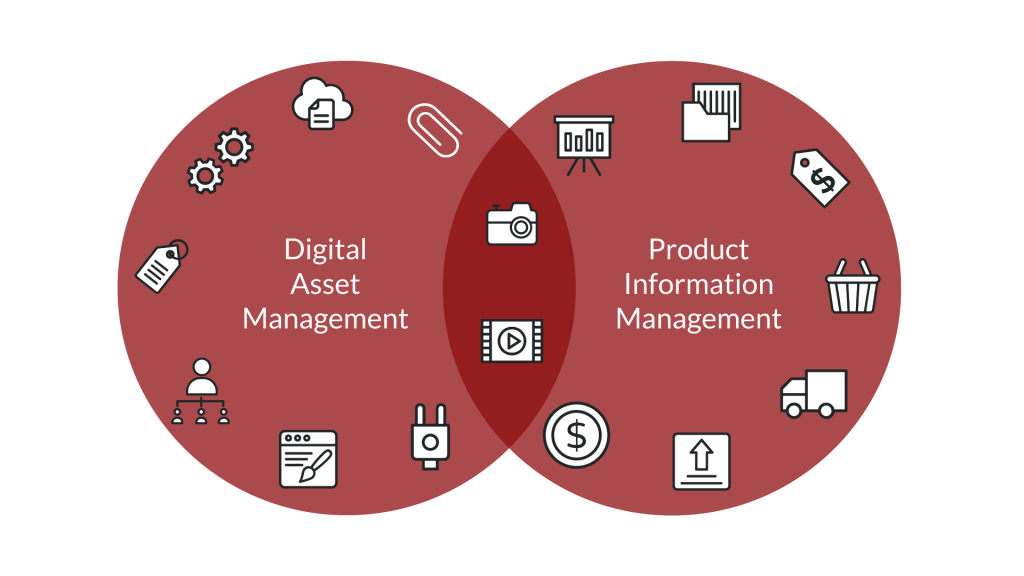Having spent a lot of time building custom software applications at the beginning of my career, there were many aspects of technology decisions that fascinate me. One of the subjects I’ve always enjoyed assisting companies with is the decision to “build vs buy” a software. Factors such as business needs, technical requirements, budget, access to talent, complexity, unique functionally, data privacy, and sometimes even tight deadlines can influence the decision. The fact that there is no “one-size-fits-all” approach always makes the conversation intriguing.
As my area of focus has shifted towards ecommerce and product information management (PIM)/digital asset management (DAM), I’ve come across a similar dilemma when picking an option. Whether you’re in product data management or you’re providing strategy and implementation services, it is highly likely that you have been involved in a conversation surrounding “PIM vs DAM.”
It is not so much a question of whether the companies should build or buy these applications, but rather should they purchase one single software application that would manage product data and digital assets, or should they invest in two separate software applications. Each situation is unique, and it is key to understand the needs of the organization and the depth of their product management, as well as their digital asset management processes, when making this decision.
What are these systems?
Both these systems are designed to help organizations manage data and digital assets. If a company manages a product catalog, it is safe to assume that they have some form of PIM. It might be a spreadsheet or combination of back-end applications (ex: ERP, PLM, network folders), or preferably a standalone PIM platform. PIM applications have come a long way over the years; they’ve evolved to not only manage and syndicate product information, but to also have the functionality to manage digital assets that are typically web, print, or syndication-ready. A PIM system is a single source of truth for product information and the digital assets of that product.
A DAM application is designed to hold organization-wide assets such as design files (Ex: CAD, PSD), web and print-ready images, PDFs, spreadsheets, video files, and so on. These assets do not have to be associated with product information; they could be marketing content (such as banners, flyers), brand files (ex: logos, styles), sketches, instructions, campaign videos, etc. In addition to storage, a DAM would also enable designers to collaborate on projects through a workflow process.
A product could originate in PIM, whereas a digital asset would originate in a DAM.
Use Case
A manufacturer with an in-house design team would need a DAM system that the design team can leverage for collaboration and the storage of high-resolution files. Once the product design is approved, the product team is ready to price the item, and it’s time to sell it through their stores, then that product information such as name, description, attributes, and more would be input and managed within a PIM system.

There is certainly an overlap in some functionality that these platforms offer, and the topic requires a deeper dive to uncover the business use cases in order to get to a decision around which platform(s) an organization should invest in.
Making an investment decision
As organizations look to scale their technology landscape and bring efficiency to their product design and catalog creation processes, some of the following questions might come up internally:
- We bought a PIM license; should we also purchase a DAM system?
- Can PIM resize images? Can PIM maintain versioning on assets or is that something a DAM is better equipped to do?
- Which system is recommended for creating asset management workflow and governance?
- We have a DAM already; now that we’re investing in a PIM system, will it hold all our digital assets. Should we decommission DAM?
- We own a PIM as well as a DAM product license. What type of assets should be stored in each respective system?
These and more such questions could serve as points of discussion for a detailed workshop with your technology partner and will help uncover the further use cases and eventually get to a technology investment decision. To get answers to these questions and more, reach out to Perficient for an analysis session.


Great blog! It makes one think about the importance of the title!
Awesome blog Ritesh
Brands and retailers that have hesitancy in delegating control should either have it designed internally or invest in solutions that provide highly integrated systems functioning with product information management and other core processes.Product asset management is designed to store each and every product-related information that is utilized across the whole system.Thanks for providing insights on PIM & DAM here.
Nice Blog, Good data about Product Information Management and information which we can store in PIM. Keen to read upcoming blogs from your blog page